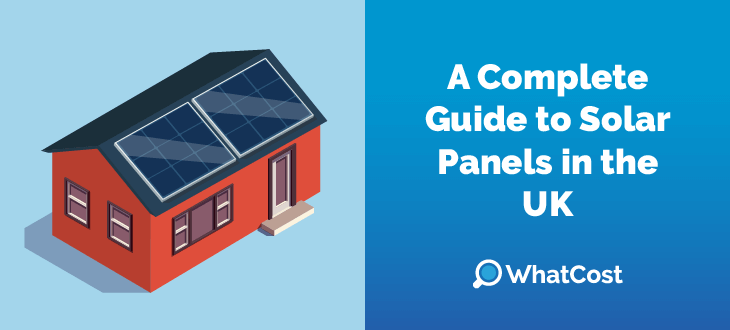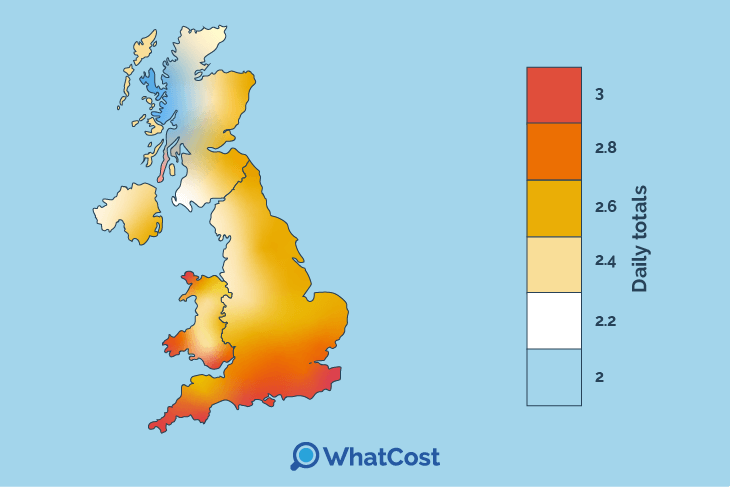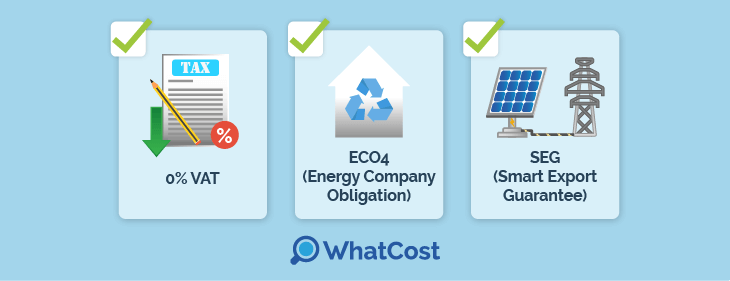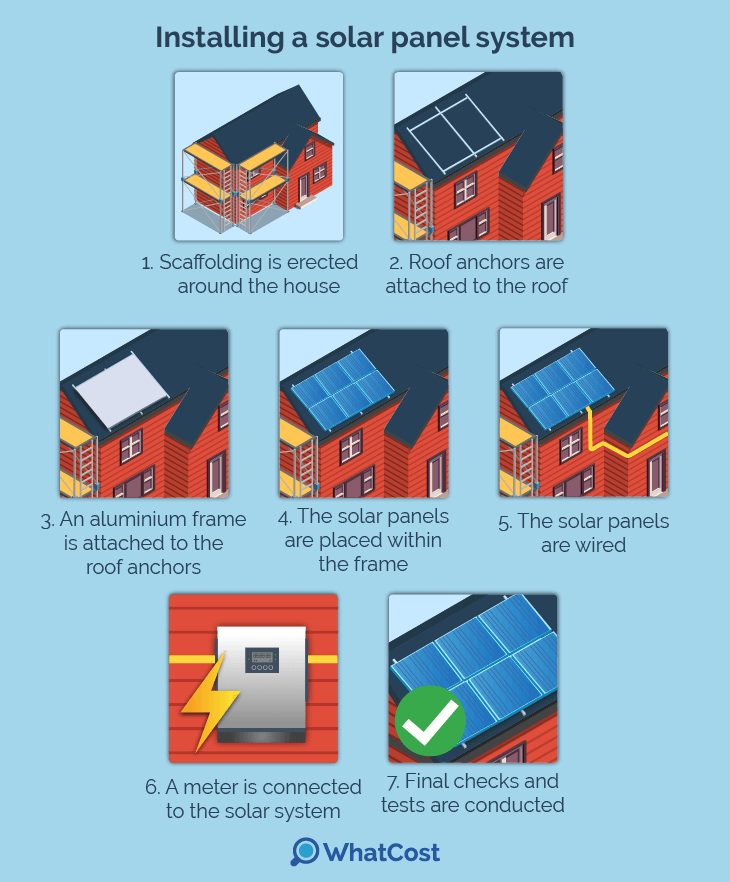Answer these simple questions and we will find you the BEST prices
Which type of solar quotes do you need?
It only takes 30 seconds
100% free with no obligation

Get up to 4 quotes by filling in only 1 quick form

Compare quotes and find yourself the best deal

Increase the value of your home by installing solar panels
- whatcost.co.uk
- Solar Panels
Solar Panels for UK Homes: Complete 2025 Guide


- The average cost for a 4kW solar panel system is £6,600 - £8,100, saving £1,304 per year.
- The system will break even in 6 years.
- Solar panels help improve home value and earn back money through SEG tariffs.
Solar panels provide energy independence and savings, sparing you from excess bills and making your home eco-friendly. While they are a great solution for many homes, figuring out which solar panel system to install can be tricky. Luckily, this guide will walk you through all the pros and cons, costs, and other necessary details so you can make the best choice for your home.
If you’re looking to install solar panels, you will need a professional installer to get the job done. Finding the right one at the right price can be a hassle that takes hours of researching companies and calling them up. However, with our service, finding a reliable professional has never been easier. All you have to do is fill out a 30-second form, and we’ll provide you with up to 4 free, non-binding quotes.
Click the button below to get started.
- Quotes from local installers
- Payment by finance available
- Save up to £915 per year
It only takes 30 seconds

- What are solar panels and how do they work?
- Are solar panels for homes worth it in the UK?
- Detailed breakdown of solar panel costs
- How much can solar panels save you?
- Other benefits of installing solar PV panels on your UK home
- Potential downsides to residential solar panels
- What does the installation process look like?
- Is it a good idea to add a solar battery to your solar panel system?
- Is your home suitable for solar panels?
- How to find and compare solar panel quotes
- FAQ
What are solar panels and how do they work?
A solar panel system is comprised of photovoltaic panels that generate electricity using sunlight. The sunlight hits the panels, photons are converted into electricity, and then used, stored in a battery, or sent back to the grid for additional earnings. The animation below breaks down the process in more detail (click the buttons on the image to learn more):
PV panels consist of solar cells, which are made out of semiconductors like silicon. The solar cells are connected in a frame, which is what we know as a solar panel. Energy is generated when photons from sunlight come in contact with electrons in the silicon in the solar panels. Energy is then released in the form of usable electricity for your home.
Solar panels in the UK generally have high efficiency levels, reaching ratings of up to 24%. This is mostly the same as in other parts of the world where solar panels can be installed. Considering that the highest efficiency levels of solar panels are around 23%, 20% efficiency for solar panels in the UK is a great percentage.
These days, solar PV panels tend to be between 400W and 500W per panel, with a 4kW solar panel system being ideal for the average 2 to 3-bedroom house.
Are solar panels for homes worth it in the UK?
Yes. Solar panels can be a great benefit to most homes in the UK. They allow for protection against price rises on the fossil fuel grid, generate renewable energy, and last for decades.
Solar panel prices can vary based on the size of your home. Here is a basic breakdown of the cost of common systems and how much they can save each home size.
| House size | Solar system size | System cost | Annual savings | Break even point (years) |
|---|---|---|---|---|
| Small; 1-2 bedrooms | 3kW | £5,700 - £7,000 | £783 | 7 |
| Medium; 2-3 bedrooms | 4kW | £6,600 - £8,100 | £1,304 | 6 |
| Medium; 2-3 bedrooms | 5kW | £8,300 - £10,200 | £1,304 | 6 |
| Large; 4-5 bedrooms | 6kW | £10,000 - £12,200 | £1,567 | 6 |
These costs are estimates. Get a local installer QUOTE now!
Installing solar panels for house energy needs can help cover all your electricity needs. Aside from that, they also cut 50 grams of carbon emissions for every 1kWh they produce, which can mean a 170,000kg decrease in carbon per year for a 4kW system.
Is the UK sunny enough for solar panels?
Yes. The UK has adequate sunlight hours for solar panels to operate properly. While 4 hours of average peak sunlight hours might seem low, an average-sized solar panel system (4kW) can generate the energy needed for most homes.
There are some considerations that can impact the effectiveness of such a system. It is important to have a south-facing roof in the UK for an ideal position for energy generation, but other directions like West or East can also suffice, albeit with a bit less energy output. The roof also needs to be unobstructed by shade.
As the chart below shows, the daily totals can allow for enough energy to be generated per day in most regions.

That said, there are some differences in the power output of solar panels depending on where in the UK they are installed. For instance, a 4kW solar panel system will generate varying levels of energy throughout the year based on where your home is located. In London, they can produce up to 475kWh in the summer months, while in Manchester, the same system can generate about 400kWh in the same period.
Ultimately, the power you generate will depend on the size of your system and how well it matches your home’s requirements. The larger your home, the bigger the system you will require.
Detailed breakdown of solar panel costs
It’s important to factor in the labour costs of solar panels along with the purchase costs.
| Household Size | System Size | Estimated Costs | Estimated Labour Costs | Estimated Total Costs |
|---|---|---|---|---|
| Small; 1-2 bedrooms | 2 - 3kW | £2,500 - £5,500 | £600 – £1,000 | £3,100 – £6,500 |
| Medium; 2-3 bedrooms | 4 - 5kW | £5,000 - £8,500 | £1,000 – £2,000 | £6,000 – £10,500 |
| Large; 4-5 bedrooms | 6kW | £9,500 - £10,500 | £2,000 – £3,000 | £11,500 – £13,500 |
Solar panels can be insured by most home insurance policies, so you may not need an entirely new policy to insure them. The additional solar panel coverage will cost about £100 to £200 per year. While insurance can be pretty great for wider coverage and extra assurance, a good warranty may be good enough for most homeowners as solar panels are quite durable.
In terms of upkeep, house solar panels have virtually no maintenance costs. Many homeowners may have to clean them lightly twice a year, but this can be done with most home cleaning supplies and a light brush.
Are there grants available to cut down on the costs?

Grants that can help decrease the cost of solar panels include the ECO4 scheme, the Smart Export Guarantee, and the 0% VAT scheme. Grants are available in most areas of the UK, but there may be regional exceptions, which is why it’s best to ask a local installer.
- 0% VAT: 0% VAT applies to UK solar panels and batteries up until 31st March 2027. The VAT reduction means that homeowners can save over £1,850 on solar panel installation automatically, compared to a 20% rate. The main requirement to benefit from the VAT reduction is that your solar panels and installation need to be purchased together.
- ECO4 (Energy Company Obligation): This scheme assists low-income households by replacing inefficient energy solutions (specifically heating systems) with more environmentally friendly options. To qualify for the ECO4 scheme, you must have inefficient energy systems in your home and receive government benefits. With ECO4, you can save anywhere between £290 and £1,600 annually, depending on your situation.
- SEG (Smart Export Guarantee): This initiative allows you to sell surplus energy generated by your solar panels back to the grid and receive payments. All homeowners with a solar system are eligible under the SEG, provided that they have a smart meter that can measure energy exports. By selling your excess electricity, you can earn up to £200 a year with the SEG, depending on the exact tariff from your energy provider.
There are also other programs that may be more regional. For example, Home Energy Scotland is one of the alternative grants for solar panels in Scotland.
How much can solar panels save you?
Over the course of its lifespan, a 4kW solar panel system will save £32,608. It will continue to generate £745 to £840 every year, and this will all become revenue once it is past its break-even point. This comes down to an ROI of roughly £19,000 - £21,000.
| House size | Solar system size | Electricity generated per year (kWh) |
Annual savings | Savings after 25 years |
|---|---|---|---|---|
| Small; 1-2 bedrooms | 3kW | 2,550 | £783 | £19,578 |
| Medium; 2-3 bedrooms | 4kW | 3,400 | £1,304 | £32,608 |
| Large; 4-5 bedrooms | 6kW | 5,100 | £1,567 | £39,163 |
With the addition of the SEG payments, you can add another £100 to £170 to the earnings. However, this will depend on what tariff rates your energy provider offers, which can vary wildly.
It’s important to note that the numbers we provide are estimates, and the real figures can vary based on your individual circumstances. That’s why it’s important to find a reliable installer who can assess your situation honestly and provide the best price. Luckily, we have a network of thoroughly vetted installers you can easily access with minimal effort.
All you have to do is click the button below and fill out a 30-second form, and you’ll receive up to 4 free, non-binding quotes.
- Quotes from local installers
- Payment by finance available
- Save up to £915 per year
It only takes 30 seconds

Other benefits of installing solar PV panels on your UK home
Other advantages of installing solar panels include:

- Energy independence: Achieve self-sufficiency and escape rising energy prices. Installing solar panels will allow users to make their own electricity on their own terms, producing up to 3,000 - 3,400kWh per year for a 4kW system. Also, solar panels for swimming pools reduce heating costs, making them a smart choice for pool heating.
- Extra passive income: By exporting energy, you can earn back money to the tune of between £75 and £170 per year on top of the free electricity. This can help pay back the cost of the panels even faster.
- Increased home value: Domestic solar panels can help increase the value of a house between 5% and 10%. This can boost the resale value and give your home a unique selling point on the market.
- Sustainable energy: Escaping the gas grid can be a powerful asset. This is especially true as the UK is trying to shift towards fewer gas-based technologies, which may become expensive in the long run.
- Grants & financing options: Government initiatives like the ECO4 scheme and the Smart Export Guarantee can help pay off the solar panel system faster.
Potential downsides to residential solar panels
There are some potential downsides one should consider before installing solar panels. These include:

- High initial cost: Getting solar panels for home energy generation can be cost-prohibitive for many households, especially if they are not eligible for grants or incentives.
- Space requirements: Not all homes have suitable roofs for solar panels. Many roofs may face the wrong direction or have limited space for home solar panels. Ground-mounted arrays can be one option if you have sufficient outdoor space.
- Time-dependent: Solar panels gather energy during daylight hours which can make them less of a night time solution. You can remedy this by adding a solar battery, although this will increase the cost of your system.
What does the installation process look like?

- Step 1: The installers prepare scaffolding around your house to be able to access your roof with ease.
- Step 2: Roof anchors are attached to the surface of your roof. These will hold the solar panels in place.
- Step 3: An aluminium frame is attached to the roof anchors.
- Step 4: The solar panels are placed within the aluminium frame and secured firmly.
- Step 5: The solar panels are wired to connect to the inverter, which is the part of your system that transfers the energy your solar panels generate to your home for use.
- Step 6: Your system will be connected to a generation meter, which will measure the energy your solar panels produce.
- Step 7: The installers conduct final checks and test that your solar panel system functions optimally.
If all these steps have been adequately addressed and completed, your home should be ready to receive energy directly from the sun.
Is it a good idea to add a solar battery to your solar panel system?
A solar battery can provide off-grid power when the sun is down. While batteries add to the cost, they are crucial in utilising energy efficiently. A battery will set you back another £3,500 to £7,000 for a standard solar panel system.
However, solar batteries provide some additional benefits one should consider:
- Savings from off-peak electricity: Storing energy for use during the hours when it is more expensive can save £2 to £4 per day.
- Fully off-grid energy: Solar batteries allow for full off-grid power usage.
- Reduced emissions: By storing energy and using it when needed, you decrease your reliance on the energy grid.
Is your home suitable for solar panels?
Solar panels are easy to install for most homes, offering a range of options to suit most setups. However, there are certain elements that can affect how suitable your home will be for solar panels. Let’s go over the most crucial ones.
Electrical considerations
Generally, your electrical system should be fine with its current setup. Anything over 5kWs might need a more heavy-duty fuse box. A better electrical panel or breaker box might be necessary since this is where electricity is divided into different circuits.
One consideration for installing solar panels is the number of phases your electric connection has. Single-phase connections will need single-phase solar inverters, while any 3-phase connection provides a wider range of connections. The simplest solution is to get a 3-phase inverter, which will distribute the solar power evenly across all three phases.
Another option is to install single-phase inverters on one of the phases in the home, but it can be less preferable if the solar panel setup is too large. This could cause the inverter to trip out from high voltage or flow to the wrong phase. A third option is to install multiple single-phase inverters, which can be more expensive.
Connecting your first set of solar panels will not require permission (unless you live in a conservation area), but you will need permission for any expansion you make to the system afterwards.
Another aspect to consider is the installation of a smart meter. While solar panels will work fine without one, if you’re looking to make back money with SEG tariffs, you will require one.
Roof placement
As mentioned earlier, roofs need to be south-facing for ideal sunlight capture. A 30° to 40° roof pitch is the best angle for solar panels in the UK. A lot of PV solar panels can be properly angled with brackets to meet this angle if the roof does not automatically match the requirements.
Roof solar panels require about 2m square per panel. With this rule of thumb in mind, it’s important to free up roughly 16m2 to 20m2 for a 4kW system.
| System size | Number of panels (350W to 500W) |
Physical dimensions |
|---|---|---|
| 2 - 3kW | 4 - 8 | 8 - 16m2 |
| 4 - 5kW | 8 - 13 | 16 - 26m2 |
| 6kW | 12 - 16 | 24 - 32m2 |
The area around the roof needs to be unobstructed by shade, providing a flow of sunlight directly to the panels. Solar panels should also not be placed around taller buildings, which might block their access to the sun. It can also be harder to install solar panels on a house with lots of obstructions, such as chimneys and other elements that might interrupt a direct installation.
Roof materials
Most solid roofs can handle solar panels and are fit for them. Composite shingle roofs are very common and make for great solar panel installations. Solar panels can be easily attached to these roofs and hold up the system.
Other roofs, like clay or ceramic tiles, can be more expensive to replace. These also have some placement considerations, such as placing brackets that lift the panels above the roof. Wood roofs can be completely unsuitable for solar panels and may need another layer before any installation can be added.
An older roof that is facing more wear and tear will need to be replaced before solar panels are installed. This adds to the labour cost of installation along with the time it will take to implement your new system.
How to find and compare solar panel quotes
It’s important to always look for multiple quotes from different installers. All the prices we provide are estimates, so it's crucial to get a price from someone who can assess your specific situation and provide a tailored quote. Here’s what to look out for when looking for prices:
- Make sure the installer has an MCS certificate.
- Check their online reviews and customer feedback.
- Compare their offers to prices from other companies.
- Research the panels that they are providing.
- Request a layout plan to see what they plan to do to your roof.
- Check the warranties on all relevant technologies.
Finding the right installer can be complicated, but we can give you a head start. We have an entire network of fully vetted installers who can provide the best prices with none of the hassle of spending hours researching companies. All you have to do is click the button below, fill out a 30-second form, and you can receive up to 4 free, non-binding quotes.
- Quotes from local installers
- Payment by finance available
- Save up to £915 per year
It only takes 30 seconds

FAQ
Yes. Solar panels increase home value by 4% to 5% in terms of resale value, among many other advantages.
It’s not obligatory, but you must inform your electricity provider if you want to earn back money through the Smart Export Guarantee.
Most solar panels are covered by standard home insurance. They can add £100 to £200 more to the annual bill. This can add to the cost of solar panels, but it’s important to note that insurance isn’t mandatory.
A standard 4kW system will require 8 to 13 solar panels, depending on the output per panel. However, system sizes can vary based on the desired output.

Rawal is an ex-tech journalist with a passion for sustainable innovations, green policies, and their adoption. With a straightforward writing style meant to be easily digested but full of handy tips, they are geared towards readers of all levels of familiarity with the technologies and home appliances covered.
- Solar Panels for UK Homes: Complete 2025 Guide
- What are solar panels and how do they work?
- Are solar panels for homes worth it in the UK?
- Detailed breakdown of solar panel costs
- How much can solar panels save you?
- Other benefits of installing solar PV panels on your UK home
- Potential downsides to residential solar panels
- What does the installation process look like?
- Is it a good idea to add a solar battery to your solar panel system?
- Is your home suitable for solar panels?
- How to find and compare solar panel quotes
- FAQ
